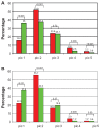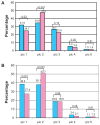Evidence for preferences of Italian patients for physician attire
- PMID: 22573935
- PMCID: PMC3346157
- DOI: 10.2147/PPA.S29587
Evidence for preferences of Italian patients for physician attire
Abstract
Background: The relationship between patient and physician is a complex interaction that includes multiple factors. The objective of this study was to explore Italian patients' preferences regarding physician appearance.
Methods: A questionnaire was developed to survey patients in different medical and surgical settings; each subject was asked to choose one picture of either a male or female physician from a selection of different attires (professional, casual, surgical scrubs, trendy, and careless). Patients were also surveyed about issues such as the presence of a name tag, hair length, trousers on women, amount of makeup, presence of tattoos, and body piercing. Statistical analysis was performed using a Chi-square test.
Results: A total of 765 questionnaires (534 completed from patients waiting for an internal medicine visit and 231 for other subspecialties) were completed. The majority (45%) of patients preferred the gastroenterologist to wear a surgical scrub with a white coat. For the other specialists, patients accepted either scrubs or formal dress under a white coat (P ≤ 0.05), with a name tag. Trendy attire was preferred by nine patients (1.1%). The entire sample judged it inappropriate for clinicians to have long hair, visible tattoos, body piercing, and, for women, to wear trousers and use excessive makeup.
Conclusion: This is the first study conducted in Italy regarding physician attire. As in other Western countries, Italian patients favor physicians in professional attire with a white coat. Wearing professional dress is part of "etiquette based medicine" and may favorably influence clinician-patient relationships and patient compliance.
Keywords: appearance; etiquette medicine; physician attire.
Figures





References
-
- Jones WHS. Hippocrates. Volume. Vol. 2. Cambridge, MA: Harvard University Press; 1923.
-
- Gjerdingen DK, Simpson DE, Titus SL. Patients’ and physicians’ attitudes regarding the physician’s professional appearance. Arch Intern Med. 1987;147:1209–1212. - PubMed
-
- Van Dulmen AM, Verhaak PFM, Bilo HJG. Shifts in doctor-patient communication during a series of outpatient consultations in noninsulin-dependent diabetes mellitus. Patient Educ Couns. 1997;30:227–237. - PubMed
-
- Short D. First impression. Br J Hosp Med. 1993;50:270–271. - PubMed
-
- Rose A. Human Behavior and Social Process. Boston, MA: Houghton Mifflin Co; 1962.
LinkOut - more resources
Full Text Sources
Research Materials

